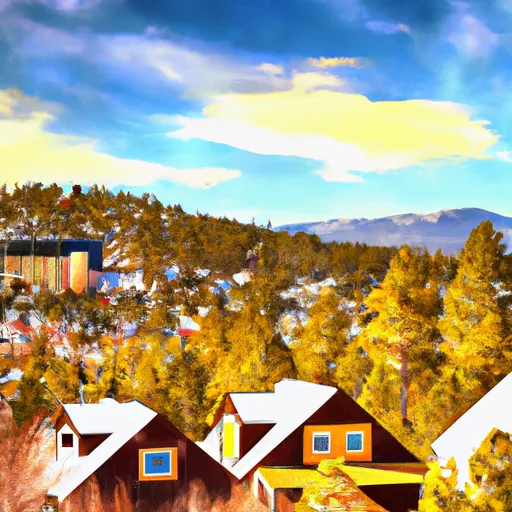-
 Snoflo Premium
Snoflo Premium
Get unlimited access to all our content
With no Ad interruptions! - Start Your Free Trial Login with existing account
Incline-Village
Eden Index
Climate
8.4
•
Recreation
8.2
•
Community
4.5
•
Safeguard
7.3/10

Incline Village is a picturesque community located on the north shore of Lake Tahoe in Nevada. Known for its stunning natural beauty, it offers a unique blend of alpine landscapes and crystal-clear waters. The climate in Incline Village is characterized by four distinct seasons. Winters are cold and snowy, with temperatures often dipping below freezing, making it an ideal destination for winter sports enthusiasts. Summers are warm and sunny, with temperatures ranging from the mid-70s to mid-80s Fahrenheit.
As for hydrology constituents, Incline Village is nestled in the Lake Tahoe watershed, which is renowned for its exceptional water quality. The pristine waters of Lake Tahoe offer countless recreational activities such as swimming, boating, fishing, and paddleboarding. With over 300 days of sunshine per year, outdoor enthusiasts can also enjoy hiking, mountain biking, and golfing in the surrounding Sierra Nevada mountains.
Incline Village is also home to several parks and beaches, including the popular Sand Harbor State Park, which features sandy beaches, picnic areas, and a performing arts center. The region's diverse wildlife and scenic beauty make it a perfect destination for nature lovers and outdoor adventurers alike.
What is the Eden Index?
The Snoflo Eden Index serves as a comprehensive rating system for regions, evaluating their desirability through a holistic assessment of climate health, outdoor recreation opportunities, and natural disaster risk, acknowledging the profound impact of these factors on livability and well-being.
Climate Health Indicator (CHI): 8.4
Incline-Village receives approximately
623mm of rain per year,
with humidity levels near 60%
and air temperatures averaging around
7°C.
Incline-Village has a plant hardyness factor of
7, meaning
plants and agriculture in this region tend to thrive during the non-winter months.
By considering the ideal temperature range, reliable water supplies, clean air, and stable seasonal rain or snowpacks, the Climate Health Indicator (CHI) underscores the significance of a healthy climate as the foundation for quality living.
A healthy climate is paramount for ensuring a high quality of life and livability in a region, fostering both physical well-being and environmental harmony. This can be characterized by ideal temperatures, reliable access to water supplies, clean air, and consistent seasonal rain or snowpacks.
Weather Forecast
Streamflow Conditions
Truckee
Area Rivers
Truckee
Snowpack Depths
Truckee
Reservoir Storage Capacity
Truckee
Groundwater Levels
Recreational Opportunity Index (ROI): 8.2
The Recreational Opportunity Index (ROI) recognizes the value of outdoor recreational options, such as parks, hiking trails, camping sites, and fishing spots, while acknowledging that climate plays a pivotal role in ensuring the comfort and consistency of these experiences.
Access to outdoor recreational opportunities, encompassing activities such as parks, hiking, camping, and fishing, is crucial for overall well-being, and the climate plays a pivotal role in enabling and enhancing these experiences, ensuring that individuals can engage in nature-based activities comfortably and consistently.
Camping Areas
| Campground | Campsites | Reservations | Toilets | Showers | Elevation |
|---|---|---|---|---|---|
| Meeks Bay | 40 | 6,225 ft | |||
| Fallen Leaf | 206 | 6,345 ft | |||
| Camp Richardson Complex | 320 | 6,250 ft | |||
| Sugar Pine Point State Park | 175 | 6,465 ft | |||
| Nevada Beach | 54 | 6,213 ft | |||
| El Dorado | None | 6,255 ft | |||
| Camp Shelley | None | 6,256 ft | |||
| William Kent | 95 | 6,337 ft | |||
| D.L. Bliss State Park | 170 | 6,872 ft | |||
| Campground by the Lake | 170 | 6,256 ft |
Nearby Ski Areas
Catastrophe Safeguard Index (CSI):
The Catastrophe Safeguard Index (CSI) recognizes that natural disaster risk, encompassing floods, fires, hurricanes, and tornadoes, can drastically affect safety and the overall appeal of an area.
The level of natural disaster risk in a region significantly affects safety and the overall livability, with climate change amplifying these risks by potentially increasing the frequency and intensity of events like floods, fires, hurricanes, and tornadoes, thereby posing substantial challenges to community resilience and well-being.
Community Resilience Indicator (CRI): 4.5
The Community Resilience Indicator (CRI) recognizes that education, healthcare, and socioeconomics are crucial to the well-being of a region. The CRI acknowledges the profound impact of these elements on residents' overall quality of life. By evaluating educational resources, healthcare accessibility, and economic inclusivity, the index captures the essential aspects that contribute to a thriving community, fostering resident satisfaction, equity, and social cohesion.

